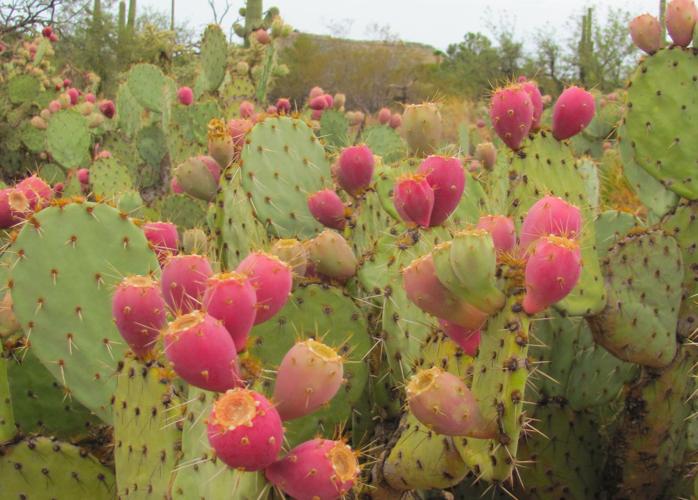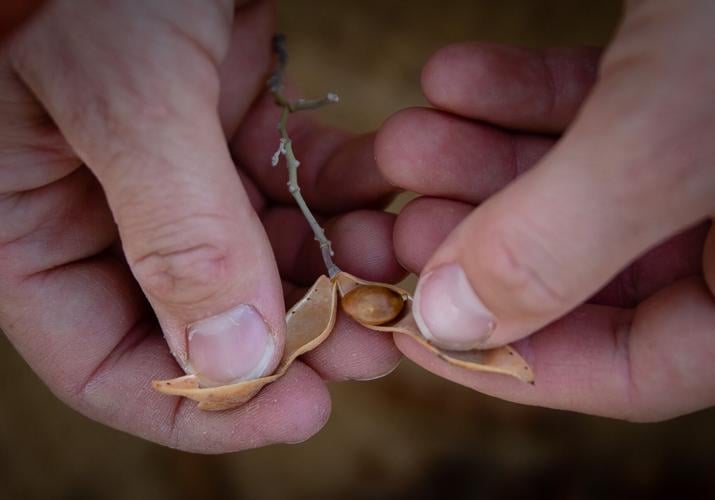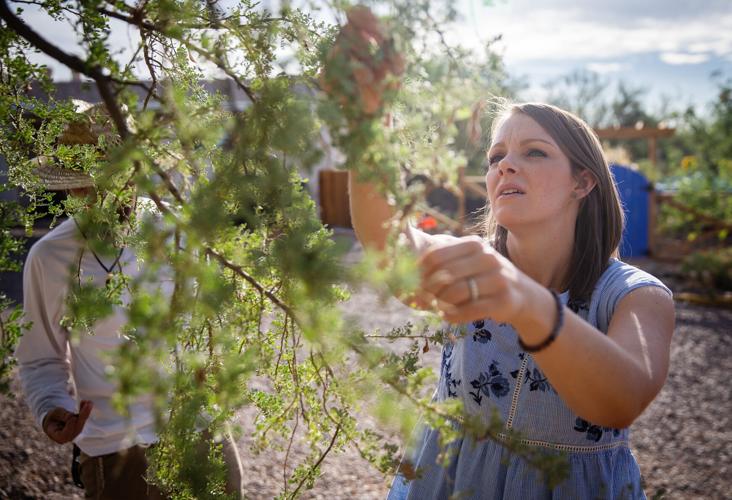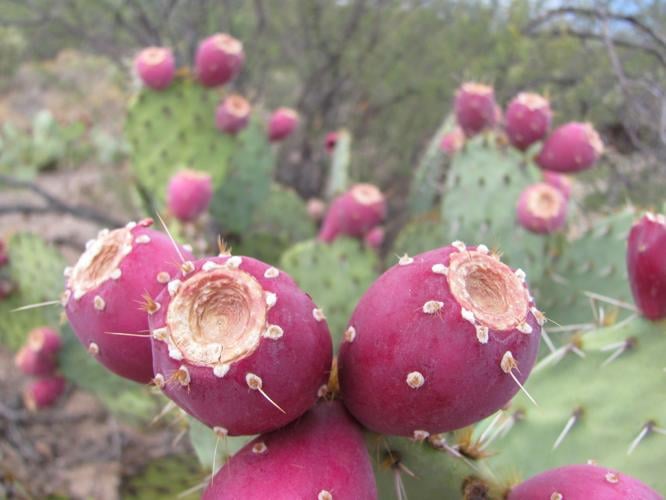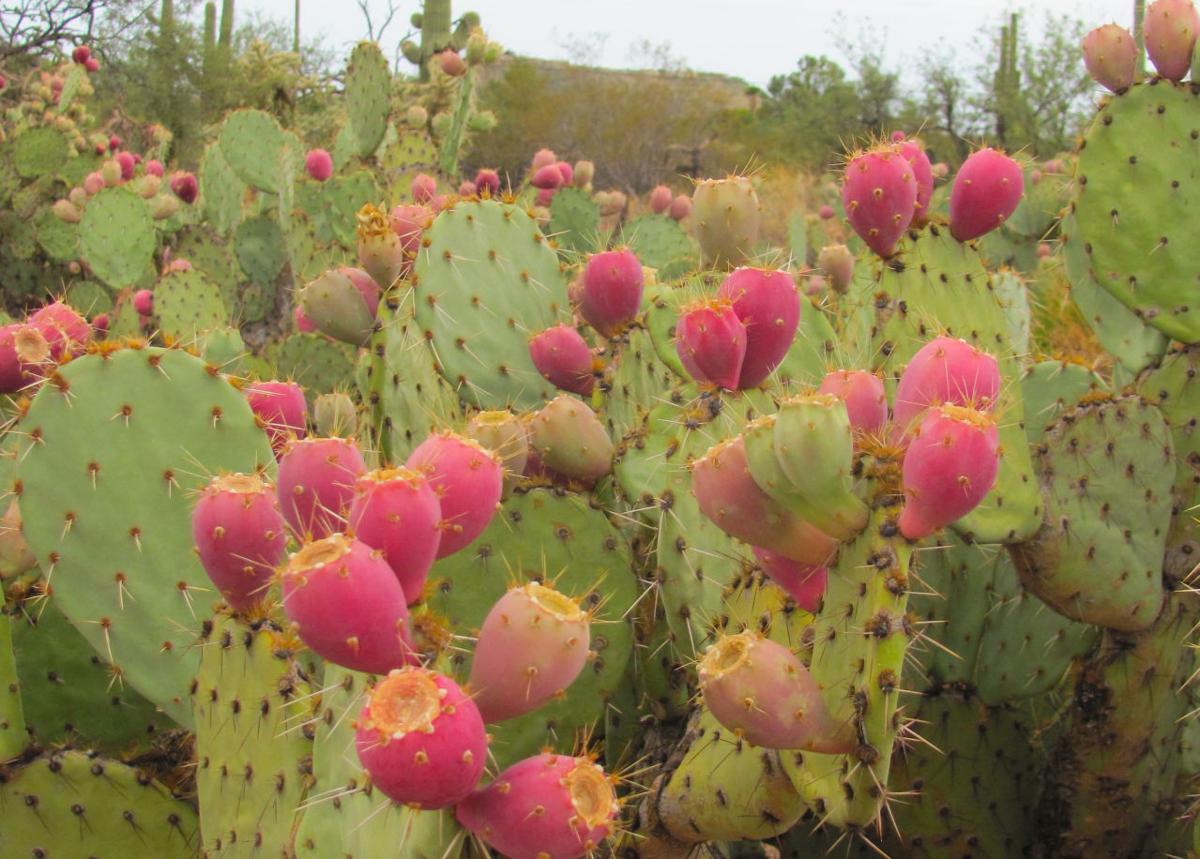Editor's note: This story was originally published in July 2020.
As grocery stores shelves emptied at the beginning of the pandemic, Terrol Dew Johnson saw a spike in interest among young people eager to reconnect with their Tohono O'odham heritage of harvesting and preparing wild desert foods.
For about 30 years, Johnson ran Tohono O'odham Community Action, a nonprofit focused on traditional foods and culture. TOCA disbanded several years ago and scaled back to focus on farming, he says. Today, Johnson is the director of the Alexander Pancho Memorial Farm in Sells, the capital of the Tohono O'odham Nation, about 60 miles southwest of Tucson.
"We're really focused on farming and the traditional food crops like tepary beans, melons, squash and corn," he says. "But we also do a lot of wild harvesting as well."
The desert's menu is vast — fruit from saguaro, prickly pear and barrel cacti; pods from mesquite and palo verde trees; cholla buds; greens that sprout after rains and more.
Johnson grew up with grandparents who regularly took him to pick saguaro fruit in the summers and wild spinach each winter, but he knows not all tribal members share those experiences or his interest. And for those newly interested, he knows not all will stick it out.
Food is ongoing in the desert — and not always easy to harvest.
"With the saguaro harvest, we're picking in triple-degree weather, and when people understand that we're going to be out there at 110 degrees, they're like, 'What!'" he says. "And then we're cooking (the saguaro fruit) over a fire, and a lot of them, you get those people who lose interest. But then you also get those who are really determined to learn."
Johnson considers food a gateway to other O'odham traditions. The saguaro harvest, for example, is also accompanied by a rain ceremony that signifies the O'odham New Year.
"Instead of going by the calendar year in January, we look at the environment and the rains that bring down the water for the plants and make everything green again," he says. "We call that our new year."
Desert foods also keep alive associated legends, songs and even language.
"With traditional foods, we use our own language to identify and refer to them," Johnson says.
He adds that traditional foods can also help with high rates of diabetes and other food-related illnesses among tribal members.
Johnson's focus is on teaching native food traditions to O'odham tribal members. For others interested in learning about edible desert plants, respect is key, he says. After all, Tucson sits on historic Indigenous land.
The region's agricultural history and heritage foods led to Tucson's designation as a UNESCO City of Gastronomy in 2015.
"It's a treasure, the knowledge of Indigenous tribes around and in Tucson," Johnson says. "What a treasure it is to have these groups promote these traditional foods, because that's how Tucson got this title."

Katherine Todd breaks open a seed from an ironwood tree.
Respecting the desert
As interest in wild desert foods grows, Johnson says there are those who exploit and commodify that abundance.
"We have gone out where people have gone illegally and harvested and used four wheelers, and it just rips up the desert..." he says. "From the very beginning, we teach our students and community members to respect the environment and the land that these foods grown on."
He points out that if you're purchasing something made with desert foods, ask where they came from and whether proceeds benefit Indigenous communities.
Barbara Rose is the permacultural designer of the 20-acre Bean Tree Farm in the Tucson Mountains and a member of the Tucson nonprofit Desert Harvesters. For years, Rose has cared for the land and taught others about native foods and how to "re-wild" their urban and suburban neighborhoods.
"We're part of a culture of people that has stolen this land from thousands of people who lived here just fine without a Safeway or Fry's or Costco," she says. "And so I think the first thing is it's really important to say to people who want to go out into the desert and harvest, don't do that. As an urbanizing area, we have destroyed so much of the wildlife quarters and habitats, not to mention traditional cultures that kept those systems healthy for thousands of years. Don't go out into the desert and take stuff without recognizing that there has to be a reciprocity."
Respecting the desert also means respecting the animals that also need to eat. Rose says her practice is to wait until the animals have had their fill.
"There is an herbalist idea that you should only harvest 10 percent of what's out there ... but if everyone harvests 10 percent, then there's none left," she says.
Johnson says O'odham tradition is to only pick what a family needs — not until the supply is exhausted.
Stick to your own backyard
While it may be enticing to head out into open desert to pick prickly pear, you actually shouldn't do that.
Many native plants in Arizona — not just saguaros — are protected, and all land in this state is owned by somebody, says Robert Smook, a spokesman for the Arizona Department of Agriculture.
"It might be state, open trust land, federal or tribal land," he says. "There is nothing that is not claimed."
That means for the most part you need permission from a property owner to harvest, for example, cactus fruit.
"If you're anywhere outside of your own property, you can't harvest flowers or plants," he says. "On tribal nations, they do harvest the fruit, and they can, because they're a sovereign nation."
Smook says you can pick cactus fruit if you're on your own property — or have permission from the owner.
There are also local organizations such as the Arizona-Sonora Desert Museum that host educational harvests.
Katherine Todd and her family live on an acre-and-a-half's worth of land near the Arizona-Sonora Desert Museum. They call the property Prickly Paradise Farm — a name one of her young sons brainstormed.
The family moved to Tucson from Minnesota two years ago, and Todd quickly began learning about edible desert plants. Compared to Minnesota's native plants, she was surprised by how easy it was to identify and find the desert's food-producing plants.

"The funny thing about this area is pretty much everyone has edible plants in their yards and they don't even realize it," she says, listing off palo verde and mesquite trees, prickly pear and barrel cacti.
And, Rose says, if you don't have those plants in your yard, plant them yourself.
"It's this idea of re-wilding your neighborhood and your backyard and bringing in that delicious Sonoran Desert bounty, not just for you, but for the soil and birds and reptiles," she says. "Bring it back if it's gone, and if there are parts of it in your neighborhood, celebrate that and take care of it and restore it."
Bring tongs and tweezers
Once you've determined that you can ethically and respectfully sample some of the desert's offerings, you'll need to be properly prepared.
There are a lot of spines out there, after all.
Prickly pear fruit for example have glochids, or spines on the fruit. So to harvest those, you'll want to wear gloves and use tongs, says Carolyn Niethammer, author of books including "Cooking the Wild Southwest: Delicious Recipes for Desert Plants."
"You pick them off and then put them in a basket or pail," she adds. "We used to spend a lot of time peeling them and stripping them, but I find the easiest thing to do is rinse them, chop them up and put them in a blender and then strain the juice. And the thorns just disappear."
Just make sure you get them all.
Harvesting cholla buds and some other cacti will also require tongs.
Todd says her boys, 7 and 4, love to use the tongs, particularly on pincushion cactus fruit.
"It's more of a cool season fruit, and it's low to the ground, and they look like hot peppers and they're sweet, delicious little fruits," she says. "It's a treasure hunt for them."
She says learning about edible plants has been a way to teach her children how to connect with and respect nature.
Saguaros in particular are revered in O'odham tradition as people and should be treated with respect. Never throw anything at the fruit to knock it down. Traditionally, the O'odham use a long pole made of saguaro ribs to gently dislodge the fruit, according this Arizona Daily Star series on saguaro harvests.
Everything in its season
"Wild foods have their season," Niethammer says. "And it starts in the spring with leafy greens and then it goes into prickly pear pads and then it's saguaros and mesquite and then prickly pear fruits and then fortunately barrel cactus is throughout that time. And as you get more into the fall, if you go a little higher, you get acorns and berries."

Prickly pear cacti in the Tucson area are laden with plump, red fruits in summer.
Desert Harvesters' "Eat Mesquite and More: A Cookbook for Sonoran Desert Foods and Living" offers the average harvest season for a variety of desert foods. Here are the harvest times for some of the most common edibles.
Prickly pear fruit: Late July through October
Chiltepin peppers: September, October
Barrel cactus fruit: November through April
Nopales (prickly pear pads): April, May
Cholla buds: March through August
Mesquite pods: Low desert - May through June, October through November; High desert - June through August and November through January
Saguaro fruit: June, early July
Plan your menu
Rose says you want to sample in moderation, especially if you're new to Sonoran Desert foods.
"Desert foods are kind of like super foods," she says. "They're so over-the-top packed with nutritious properties that you definitely don't want to eat a whole plate full of barrel cactus, because it will make you sick."
Just learning about the area's native plants is a good place to start — you want to make sure you properly identify something before you eat it. It's also important to pick some things at the proper time. Damp mesquite pods, for example, can harbor an aflatoxin that can make you sick, Rose says.
Cookbooks such as Niethammer's "Cooking the Wild Southwest: Delicious Recipes for Desert Plants" and "Eat Mesquite and More" offer recipes and guidance on how to use and harvest wild desert foods.
"If you have prickly pear juice, what other things do you like to make that have fruit in them? And then substitute," Niethammer says about experimenting. "It's the same with mesquite meal ... but people have to realize that you can't use straight mesquite meal (in baked goods). It doesn't have any gluten in it, and if you try to bake something with it, it will just be flat. And the flavor is strong."
Again it comes back to respect and curiosity.
"It makes me feel closer to where I live," says Niethammer. "To go on a hike and you see, 'Oh, this tree. I know this tree. I know this plant.' You might not be eating it right then, but it's more of an interaction and feeling like you're part of your ecosystem."


